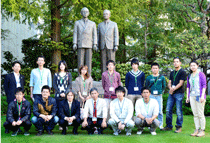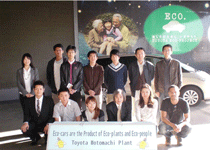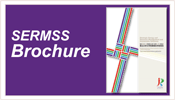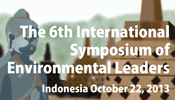Field Trip to Nagoya, Osaka and Kyoto - Regular Course
October 27-29, 2011
SERMSS students went to Nagoya, Osaka and Kyoto and visited corporations such as Toyota and Panasonic.
They also visited historical architectures to understand what ancient Japanese people leaned from international techniques.
Here are some comments from our students.
Panasonic Corporation : Nuhansyah Sulaiman(D1)
 Panasonic is well known for their high quality home goods and now they are trying to improve and reinvent the house.
A concept DC house is aiming to create a home in which the appliances uses direct current electricity thus eliminating the need for adaptors in many electronics.
The DC house concept also aims to be an ecologically conscious house in trying to produce electricity by using solar cells and storing them in batteries for use later,
thus aiming for a house to be a net producer of electricity, not just tapping from the grid.
Panasonic a producer of many electronic home goods aims to create more efficient products and aims for a larger global market.
Panasonic is well known for their high quality home goods and now they are trying to improve and reinvent the house.
A concept DC house is aiming to create a home in which the appliances uses direct current electricity thus eliminating the need for adaptors in many electronics.
The DC house concept also aims to be an ecologically conscious house in trying to produce electricity by using solar cells and storing them in batteries for use later,
thus aiming for a house to be a net producer of electricity, not just tapping from the grid.
Panasonic a producer of many electronic home goods aims to create more efficient products and aims for a larger global market.
Toyota Motor Corporation : Paulo Sousa(M2)
 The visit to Toyota Motors factory and museum was a very unique opportunity to have a look at some of the key elements that put Toyota in the position of world number 1 vehicle manufacturing company.
In the visit to the factory, we were taken to two of the four main vehicle manufacturing process, namely the welding and assembly processes (the other ones being cutting and molding, and painting).
In the welding process, we were impressed to see how more than 95% of all welding in the cars are done by robots in a highly efficient system that looked very much like something out of a science-fiction movie.
The assembly process was a place to see the main qualities of the world-wide known Toyota Production System in actual deployment. Challenge, improvement,
“go and see”, respect, and team work are principles in the Toyota Way that can be seen not only in its just-in-time production and distribution system,
but from the choice of suppliers all the way to the delivery of the final product.
The visit to Toyota Motor Corporation museum was also another chance to see all the major technological developments made in the car itself,
such as the development of electric cars and hybrid ones; I was particularly impressed and glad to see all the developments Toyota has implemented to guarantee the safety of those inside the vehicle and outside it when a traffic accident occurs.
In the museum, we were also able to see how the company sees (and strives for) a future in which developments are made not only in cars,
but in the whole transportation infrastructure, where cars and roads communicate with one another in order to achieve their dream of zero car accidents and minimum impact on the environment.
The visit to Toyota Motors factory and museum was a very unique opportunity to have a look at some of the key elements that put Toyota in the position of world number 1 vehicle manufacturing company.
In the visit to the factory, we were taken to two of the four main vehicle manufacturing process, namely the welding and assembly processes (the other ones being cutting and molding, and painting).
In the welding process, we were impressed to see how more than 95% of all welding in the cars are done by robots in a highly efficient system that looked very much like something out of a science-fiction movie.
The assembly process was a place to see the main qualities of the world-wide known Toyota Production System in actual deployment. Challenge, improvement,
“go and see”, respect, and team work are principles in the Toyota Way that can be seen not only in its just-in-time production and distribution system,
but from the choice of suppliers all the way to the delivery of the final product.
The visit to Toyota Motor Corporation museum was also another chance to see all the major technological developments made in the car itself,
such as the development of electric cars and hybrid ones; I was particularly impressed and glad to see all the developments Toyota has implemented to guarantee the safety of those inside the vehicle and outside it when a traffic accident occurs.
In the museum, we were also able to see how the company sees (and strives for) a future in which developments are made not only in cars,
but in the whole transportation infrastructure, where cars and roads communicate with one another in order to achieve their dream of zero car accidents and minimum impact on the environment.







